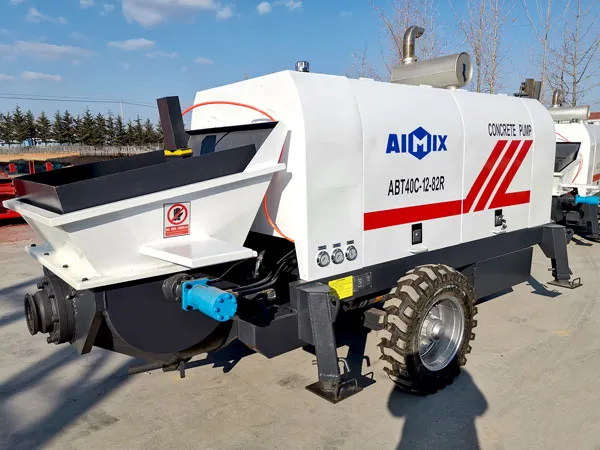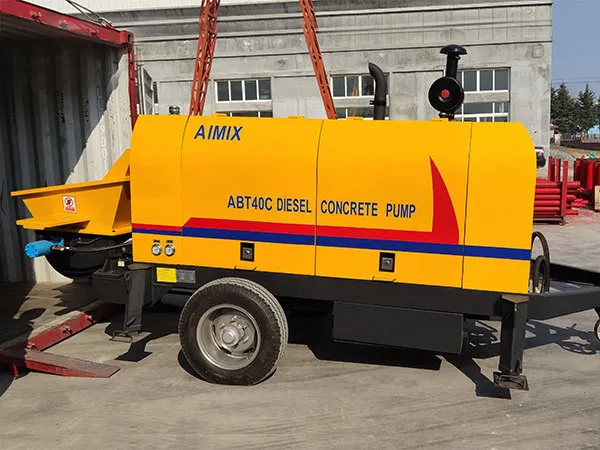Trailer pumps for concrete are crucial pieces of equipment in the construction industry, providing an efficient means of transporting and placing concrete at job sites. However, like all machinery, trailer pumps concrete require regular cleaning and maintenance to ensure optimal performance, extend their lifespan, and avoid costly repairs. Proper upkeep not only improves the efficiency of the equipment but also ensures safety on the construction site. This guide will delve into the essential steps for cleaning and maintaining trailer pumps concrete, ensuring they remain in top working condition.

Importance of Regular Cleaning
Cleaning trailer pumps concrete after each use is vital for several reasons. Concrete, once dried, can harden inside the pump and cause blockages, which may lead to pump failure or damage to the machine. Regular cleaning prevents the buildup of concrete residues, ensuring the pump operates smoothly during the next use. Moreover, clean equipment helps to maintain the quality of the concrete being pumped, as leftover debris can contaminate new batches.
Daily Cleaning Routine
After every pumping session, it’s essential to clean the pump thoroughly. Follow these steps for a daily cleaning routine:
Flushing the System: Begin by flushing the pump with water. Most trailer concrete pumps come with a water flushing system that allows you to clean the concrete pump internally. Start by running clean water through the system to remove any remaining concrete. This step is crucial to prevent the concrete from hardening inside the pump.
Using a Cleaning Ball: A cleaning ball, also known as a sponge ball, is often used to clean the pipelines. Insert the ball into the end of the pipeline, and push it through with water pressure or by running the pump. The ball will scour the interior walls of the pipeline, removing any concrete residues. Make sure to repeat this process until the ball comes out clean.
Manual Scrubbing: In areas where the cleaning ball cannot reach, manual scrubbing may be necessary. Use a brush with stiff bristles to scrub the internal parts of the pump, such as the hopper, the discharge outlet, and the valves. Pay particular attention to any areas where concrete is prone to accumulate.
Cleaning the Hopper: The hopper, where concrete is initially loaded, should be cleaned thoroughly. Remove any remaining concrete from the hopper and scrub the walls and base. Be sure to clean the grate and any other components inside the hopper to prevent concrete buildup.
Rinsing and Inspecting: After scrubbing, rinse all parts of the pump with clean water to remove any remaining debris. While rinsing, inspect the pump for any signs of wear or damage, such as cracks, leaks, or loose fittings. Early detection of issues can prevent more significant problems down the line.
Regular Maintenance Practices
In addition to daily cleaning, regular maintenance of trailer pumps concrete is essential to ensure their long-term reliability and performance. Maintenance involves checking and servicing various components of the pump to prevent breakdowns and extend the equipment’s lifespan.
Weekly Maintenance Checklist
Inspect Hydraulic System: The hydraulic system is the heart of a trailer pump. Check the hydraulic fluid levels and top them off if necessary. Inspect hoses and fittings for leaks or signs of wear. Also, check the hydraulic pump and motor for any unusual noises or vibrations that could indicate a problem.
Lubrication: Regular lubrication of moving parts is crucial to reduce friction and wear. Check the manufacturer’s (like Aimix) recommendations for lubrication intervals and apply the appropriate grease or oil to all necessary components. Pay special attention to the pump’s bearings, pivot points, and joints.
Check the Seals and Gaskets: Seals and gaskets prevent leaks and ensure that the pump operates under the correct pressure. Inspect these components regularly for signs of wear, such as cracks or deformation, and replace them as needed to maintain the pump’s efficiency.
Examine the Electrical System: For pumps with electrical components, it’s essential to inspect the wiring and connections regularly. Look for any signs of fraying, corrosion, or loose connections, and repair or replace damaged wires as necessary. Also, test the pump’s controls and switches to ensure they are functioning correctly.
Assess the Wear Parts: Trailer pumps concrete have several wear parts that need regular inspection and replacement. These include wear plates, cutting rings, and the piston cups. Check these parts for signs of wear and replace them as needed to avoid pump inefficiencies or failures.
Monthly Maintenance
Hydraulic Oil Change: Depending on the pump’s usage, the hydraulic oil should be changed every few months or according to the manufacturer’s specifications. Fresh hydraulic oil helps to maintain the pump’s pressure and prolong the life of the hydraulic components.
Filter Replacement: The hydraulic system and the fuel system (in diesel-powered pumps) often have filters that need regular replacement. Check these filters monthly and replace them if they are dirty or clogged to prevent damage to the system.
Inspect the Boom and Pipelines: For pumps equipped with booms or long pipelines, inspect these components for any signs of wear, cracks, or damage. Pay attention to the joints and clamps that hold the pipelines together, as these are critical points that can fail if not properly maintained.

Troubleshooting Common Issues
Even with regular cleaning and maintenance, trailer pumps concrete may occasionally encounter problems. Being able to troubleshoot common issues can save time and prevent minor issues from escalating into major repairs.
Blockages: Blockages in the pump or pipelines are a common issue. If you notice a drop in pumping pressure or flow, stop the pump and inspect the lines for blockages. Use a cleaning ball or high-pressure water to clear the blockage. In severe cases, you may need to disassemble the pipeline to remove the obstruction manually.
Hydraulic Issues: If the pump is experiencing hydraulic problems, such as slow or erratic operation, check the hydraulic fluid levels and look for leaks in the system. Air in the hydraulic lines can also cause issues, so bleed the system if necessary.
Electrical Problems: If the pump fails to start or the controls are unresponsive, check the electrical connections and fuses. Ensure that the battery is charged (if applicable) and that all switches are in the correct position. If the issue persists, it may require professional servicing.
Seasonal Maintenance
In addition to regular maintenance of concrete pumps, seasonal checks are vital, especially if the pump is used in varying weather conditions.
Winterizing the Pump: In colder climates, it’s essential to winterize the pump to prevent freezing. Drain the water from the pump and pipelines, and add antifreeze if necessary. Store the pump in a sheltered location to protect it from the elements.
Summer Maintenance: In hot weather, ensure that the cooling system is functioning correctly. Check the radiator (if applicable) and ensure that the hydraulic oil is not overheating. Proper ventilation around the pump can help prevent overheating issues.
Documentation and Record Keeping
Keeping detailed records of all cleaning and maintenance activities is crucial for the effective management of trailer pumps concrete. Documenting each inspection, repair, and part replacement helps track the pump’s condition over time and can be invaluable when troubleshooting issues or preparing for scheduled maintenance.
Maintenance Logs: Maintain a logbook where all maintenance activities are recorded, including dates, tasks performed, and any parts replaced. This log can help identify patterns in wear and tear and predict when future maintenance will be needed.
Service History: Keep a record of all professional services performed on the pump, such as hydraulic system overhauls or major repairs. This history can be useful for warranty claims and for assessing the pump’s overall condition.
Proper cleaning and maintenance of trailer pumps concrete are essential for ensuring their longevity, efficiency, and safety. Regular cleaning prevents the buildup of concrete residues that can cause blockages and damage the pump. Routine maintenance, including inspections, lubrication, and part replacements, keeps the pump in optimal working condition https://aimixgroup.com/concrete-pump/how-does-a-concrete-pump-work/. Troubleshooting common issues promptly can prevent minor problems from becoming major repairs, and seasonal maintenance ensures the pump is prepared for different weather conditions. By following these guidelines and keeping detailed records, you can maximize the performance and lifespan of your trailer pumps concrete, ultimately contributing to the success of your construction projects.